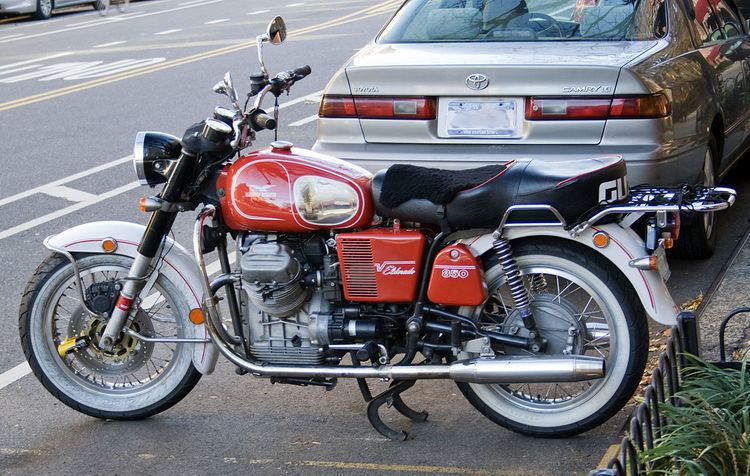Former type Private Defunct Circa 1984 (1984) | Fate Defunct Area served North America | |
 | ||
Founder Brothers Joseph and Michael Berliner Key people President Joseph Berliner, Vice President or Sales Manager Michael Berliner, Director of Public Relations Walter von Schonfeld Bob Blair Calif. Norton dealer and racing representative, Reno Leoni race bike builder sent by Ducati Place founded Manhattan, New York City, New York, United States, New York City, New York, United States | ||
Berliner motor corporation
Berliner Motor Corporation was the US distributor from the 1950s through the 1980s for several European motorcycle marques, including Ducati, J-Be, Matchless, Moto Guzzi, Norton, Sachs and Zündapp, as well as selling Metzeler tires. Berliner Motor was highly influential as the voice of the huge American market to the motorcycle companies they bought bikes from, and their suggestions, and sometimes forceful demands, guided many decisions in Europe as to which bikes to develop, produce, or discontinue.
Contents
Founding
Joseph Berliner founded his motorcycle business in New York City distributing and repairing Zündapp motorcycles east of the Mississippi in 1951, using contacts with that German manufacturer he had developed before World War II. He was a Hungarian Jewish refugee from the Holocaust who had spent time in Hungarian slave labor camps, and had lost 16 close family members on arrival at Auschwitz. Michael Berliner, the youngest of 5 brothers, was saved only because Joseph, and another Berliner brother, both of whom the SS intended to exploit for their skill as mechanics, convinced them that young Michael, too, was a mechanic. The Berliner brothers survived by maintaining a fleet of German army trucks. One brother would die of hunger and typhus, leaving only Joseph, Michael, and two other siblings alive after the war.
Prior to the Holocaust, Joseph Berliner worked in his father's radio-bicycle-motorcycle shop, and had received schooling in mechanics and business. After the war he assisted in Jewish relief in Frankfurt, Germany, and was able to find his wife who had been liberated by the Swedish Red Cross. As the sons of a Hungarian anti-Communist World War I war hero, the brothers feared returning to their Soviet-controlled homeland, and so emigrated to the US.
Motorcycles inspired
Timeline
1941
1944
1947
1951
1957
1958
1959
1961
1963
1965
1968
1984
Influence and legacy
The Berliner company is recognized by motorcycling pundits and historians as having an influence on the manufacturers they bought bikes from in proportion to the greater size of the American market to the other markets around the world, particularly during the 1950s and 60s. There is wide agreement that "bureaucrats" and "government" are the villains when the factories failed or nearly failed (as all of brands Berliner represented did at some point), as opposed to universally praised figures such as designer Fabio Taglioni.
Some place Berliner Motor Corporation squarely in the camp of those who were bringing disaster, for being "dollars and cents" businessmen. Author John F. Thompson calls Joseph Berliner a man who knew more about selling motorcycles than making them, in spite of his training and years experience as a mechanic, as well as distributor and marketer. Ian Falloon is highly critical of the low-cost pushrod two- and four-stroke single-cylinder models which Berliner demanded for their American customers, calling the entire sector "oddballs" and "dubious," while acknowledging that they did sell in far larger numbers than the much more expensive and highly labor-intensive bevel and desmo engines, whose design required production-limiting processes like shimming by skilled craftsmen. Fallloon also admits that the Berliner brainchild Ducati Scrambler single was the most successful Ducati of the 60s and early 70s. On the other side, racer, dealer, and author Mick Walker is critical of the Italian executives' decision to end production of the entry-level singles and two-strokes in the 1970s, arguing, alongside the Berliners, that the brand's customer base would decline if they only catered to the demand for expensive, high-performance machines, while not also attracting new riders and earning their brand loyalty.
The Berliner Motor Corporation's obsession with entering the large and profitable US police motorcycle market against Harley-Davidson is characterized as folly for the unrealistic specification that Berliner demanded of the Ducati Apollo, yet authors like Falloon laud the Apollo for vision of this very specification. The Apollo engine, in V-twin form, would in fact become the heart of Ducatis for the following four decades. Similarly, the Berliners pushed Moto Guzzi to create a big v-twin for the American police market, and had greater success with the production of the Moto Guzzi V7. Like Ducati, this engine type would carry Moto Guzzi from those days up to the present day, and Moto Guzzi in the end found many police department customers for their version of the Berliner dream bike.
